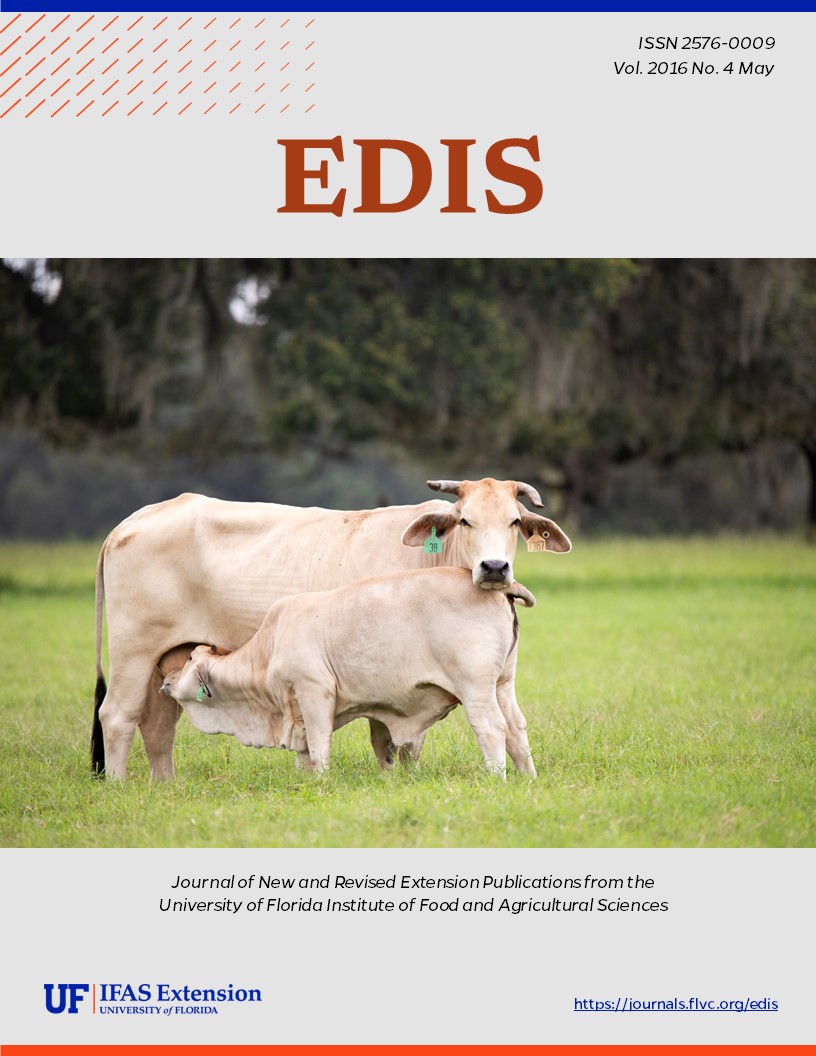Abstract
This EDIS publication is an alternate version of a page published first on the Featured Creatures website. The Featured Creatures collection provides in-depth profiles of insects, nematodes, arachnids and other organisms relevant to Florida. These profiles are intended for the use of interested laypersons with some knowledge of biology as well as academic audiences. This 6-page fact sheet that discusses the bluegrass billbug was written by Luis F. Aristizábal and Eileen Buss, and published by the UF Entomology and Nematology Department, April 2016.
References
Ahmad S, Funk R. 1982. Susceptibility of Kentucky bluegrass cultivars and selections to infestations of and injury by the bluegrass billbug (Coleoptera: Curculionidae). New York Entomological Society 90: 31-34.
Beardsley JW. 2000. The introduction and establishment of Anaphes (Potasson) calendrae (Gaham) in Hawaii (Hymenoptera: Mymaridae). Proceedings of the Hawaiian Entomology Society 34: 189-191.
Buckley RJ, Koppenhofer AM, Tirpak 5. 2010. An integrated approach to insect management in turfgrass: Billbugs. Fact Sheet FS1015, Cooperative Extension. The State University of New Jersey.
Brunner L. 1890. Report on Nebraska insects, pp. 95-106. In Report of the observations and experiments in practical work of the division. US Department of Agriculture, Washington, DC.
Buss EA, and Unruh JS. 2005. Insect management, pp. 120-130. In Trenholm LE, Unruh JB. 2005. The Florida lawn handbook, best management practices for your home lawn in Florida. Third Edition. University Press of Florida. University of Florida, Institute of Food and Agricultural Sciences. 172 pp.
Georgis R, Poinar Jr., GO. 1994. Nematodes as biopesticides in turf and ornamentals. In Leslie A. (Ed.), Integrated Pest Management for Turf and Ornamentals. CRC Press, Boca Raton, FL, USA, pp. 477-489. https://doi.org/10.1201/9780138752798-52
Georgis R, Koppenhofer AM, Lacey LA, Belair G, Duncan LW, Grewal PS, Samish M, Tan L, Torr P, van Toi RWHM. 2006. Successes and failures in the use of parasitic nematodes for pest control. Biological Control 38:103-123. https://doi.org/10.1016/j.biocontrol.2005.11.005
Haydu JJ, Hodges AW, Hall CR. 2008. Estimating the economic impact of the US golf course industry: challenges and solutions. Horticultural Sciences 43: 759-763. https://doi.org/10.21273/HORTSCI.43.3.759
Huang T, Buss EA. 2009. Billbug (Coleoptera: Curculionidae) species composition, abundance, seasonal activity, and developmental time in Florida. Journal of Economic Entomology 102: 309-314. https://doi.org/10.1603/029.102.0141
Huang T, Buss EA. 2013. Sphenophorus venatus vestitus (Coleoptera: Curculionidae) preferences for Bermudagrass cultivars and endophytic perennial ryegrass overseed. Florida Entomologist 96: 1628-1630. https://doi.org/10.1653/024.096.0455
International Commission on Zoological Nomenclature, (ICZN). 1959. Opinion 572. The Bulletin of Zoological Nomenclature 17:112-116.
Johnson-Cicalese JM, Wolfe GW, Funk CR. 1990. Biology, distribution, and taxonomy of billbug turf pests (Coleoptera: Curculionidae). Environmental Entomology 19:1037-1046. https://doi.org/10.1093/ee/19.4.1037
Kindler SD, Spomer SM. 1986. Observation of the biology of the bluegrass billbug, Sphenophorus parvulus Gyllenhal (Coleoptera: Curculionidae), in an eastern Nebraska sod field. Journal of the Kansas Entomological Society 59: 26-31.
Kindler SD, Spomer SM, Kinbacher EJ. 1983. Further host rang studies on the bluegrass billbug, Sphenophorus parvulus Gyllenhal (Coleoptera: Curculionidae). Environmental Entomology 12: 528-530. https://doi.org/10.1093/ee/12.2.528
Kuhn WR, Youngman RR, Wu S, Laub CA. 2013. Ecology, taxonomy, and pest management of billbugs (Coleoptera: Curculionidae) in orchardgrass of Virginia. Journal of Integrated Pest Management 4: 1-5. https://doi.org/10.1603/IPM12022
Peck SB, Thomas MC. 1988. A distribution checklist of the beetles (Coleoptera) of Florida. Arthropods of Florida and Neighboring Land Areas. Vol 16. Florida Department of Agriculture and Consumer Services, Gainesville, FL.
Reinert JA, Read JC, McCoy JE, Heitholt JJ, Metz SP, Bauernfeind RJ. 2006. Susceptibility of Poa spp. to bluegrass billbug, Sphenophorus parvulus. International Turfgrass Society Research Journal 10: 772-778.
Richmond DS, Niemczyk HD, Shetlar D. 2000. Overseeding endophytic perennial ryegrass into stands of Kentucky bluegrass to manage bluegrass billbug (Coleoptera: Curculionidae). Journal of Economic Entomology 93: 1662-1688. https://doi.org/10.1603/0022-0493-93.6.1662
Saliz T, Love SL, Bechinski EJ. 2014. Controlling billbug grubs in lawns. Idaho Green Thumb How-To's. University of Idaho Extension CIS 1204.
Satterthwait AF. 1931a. Key to know pupae of the genus Calendra, with host-plant and distribution notes. Annals of the Entomology Society of America 24: 143-172. https://doi.org/10.1093/aesa/24.1.143
Satterthwait AF. 1931b. Anaphoidea calendrae Gahan, a mymarid parasitic of eggs of weevils of the genus Colendra. Journal of the New York Entomological Society 39: 171-190.
Shetlar DJ. 1995. Billbugs, pp. 254-262. In: Watschke TL., Dernoeden PH., Shetlar DJ. (eds.), Managing Turfgrass Pests. Lewis Publishers, Boca Raton, FL, 361 pp.
Shetlar DJ, Silox D, Gibb TJ. 2012. Billbugs, pp. 16-18. In Brandenburg RL, Freeman CP. 2012. Handbook of turfgrass insects. Second Edition. Entomological Society of America. Lanham, MD., USA. 136 pp.
Tashiro H, Personius KE. 1970. Current status of the bluegrass billbug and its control in western New York home lawns. Journal of Economic Entomology 63: 23-29. https://doi.org/10.1093/jee/63.1.23
Vaurie P. 1951. Revision of the genus Calendra (formerly Sphenophorus) in the United States and Mexico (Coleoptera: Curculionidae). Bulletin of the American Museum of Natural History 93: 33-186.
Vaurie P. 1954. New Species of Colendro from Mexico, with Notes on Others (Coleoptera, Curculionidae). American Museum Novitates, Number 1681: 1-8.
Watschke TL, Dernoeden PH, Shetlar DJ. 1995. Managing turfgrass pests, CRC Boca Raton, FL. pp. 254-262.
Williams FX. 1929. The introduction of Anaphoidea calendroe Gahan in to Hawaii as possible eggs parasitoids of our sugar cane beetle borer, Rhabdocnemus obscurus (Boisd.). Hawaii. Planters' Rec. 33: 29-33.
Woodruff RE. 2001. Hunting billbug, Sphenophorus venatus vestitus Chittenden. Featured Creatures EENV-207, May 2001. Entomology & Nematology Department, IFAS Extension, University of Florida.

